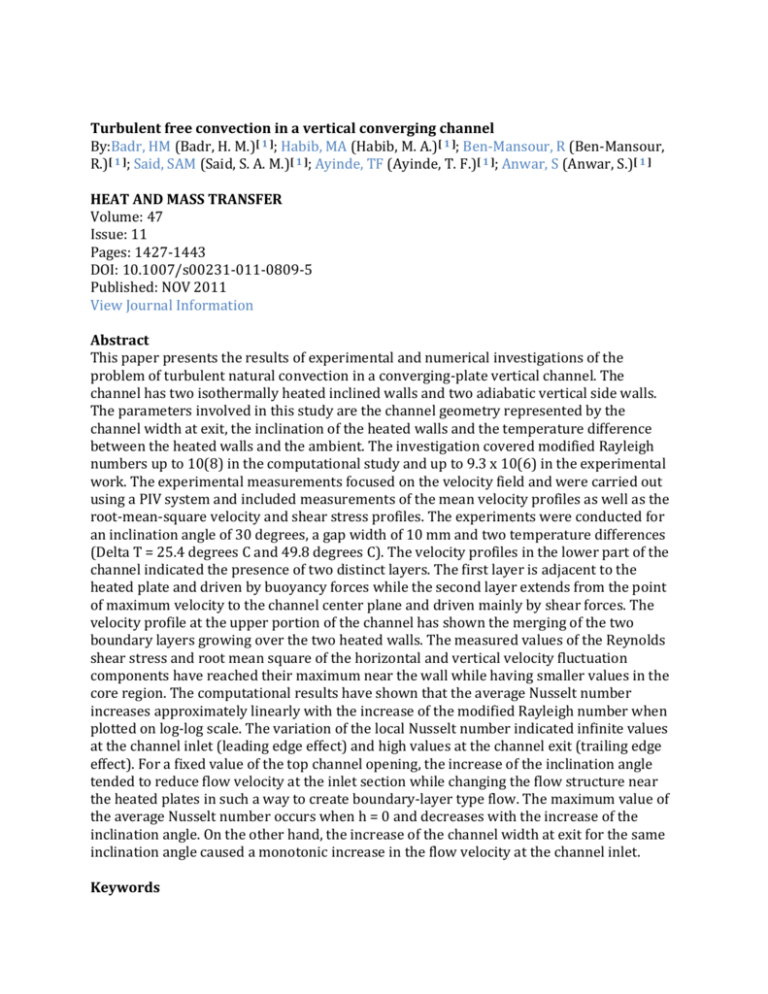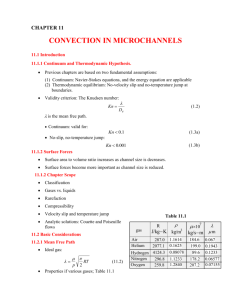Turbulent free convection in a vertical converging channel By:Badr
advertisement

Turbulent free convection in a vertical converging channel By:Badr, HM (Badr, H. M.)[ 1 ]; Habib, MA (Habib, M. A.)[ 1 ]; Ben-Mansour, R (Ben-Mansour, R.)[ 1 ]; Said, SAM (Said, S. A. M.)[ 1 ]; Ayinde, TF (Ayinde, T. F.)[ 1 ]; Anwar, S (Anwar, S.)[ 1 ] HEAT AND MASS TRANSFER Volume: 47 Issue: 11 Pages: 1427-1443 DOI: 10.1007/s00231-011-0809-5 Published: NOV 2011 View Journal Information Abstract This paper presents the results of experimental and numerical investigations of the problem of turbulent natural convection in a converging-plate vertical channel. The channel has two isothermally heated inclined walls and two adiabatic vertical side walls. The parameters involved in this study are the channel geometry represented by the channel width at exit, the inclination of the heated walls and the temperature difference between the heated walls and the ambient. The investigation covered modified Rayleigh numbers up to 10(8) in the computational study and up to 9.3 x 10(6) in the experimental work. The experimental measurements focused on the velocity field and were carried out using a PIV system and included measurements of the mean velocity profiles as well as the root-mean-square velocity and shear stress profiles. The experiments were conducted for an inclination angle of 30 degrees, a gap width of 10 mm and two temperature differences (Delta T = 25.4 degrees C and 49.8 degrees C). The velocity profiles in the lower part of the channel indicated the presence of two distinct layers. The first layer is adjacent to the heated plate and driven by buoyancy forces while the second layer extends from the point of maximum velocity to the channel center plane and driven mainly by shear forces. The velocity profile at the upper portion of the channel has shown the merging of the two boundary layers growing over the two heated walls. The measured values of the Reynolds shear stress and root mean square of the horizontal and vertical velocity fluctuation components have reached their maximum near the wall while having smaller values in the core region. The computational results have shown that the average Nusselt number increases approximately linearly with the increase of the modified Rayleigh number when plotted on log-log scale. The variation of the local Nusselt number indicated infinite values at the channel inlet (leading edge effect) and high values at the channel exit (trailing edge effect). For a fixed value of the top channel opening, the increase of the inclination angle tended to reduce flow velocity at the inlet section while changing the flow structure near the heated plates in such a way to create boundary-layer type flow. The maximum value of the average Nusselt number occurs when h = 0 and decreases with the increase of the inclination angle. On the other hand, the increase of the channel width at exit for the same inclination angle caused a monotonic increase in the flow velocity at the channel inlet. Keywords KeyWords Plus:PARALLEL-PLATE CHANNEL; NATURAL-CONVECTION; HEAT-TRANSFER; AIR Author Information Reprint Address: Badr, HM (reprint author) King Fahd Univ Petr & Minerals, Dept Mech Engn, Dhahran 31261, Saudi Arabia. Organization-Enhanced Name(s) King Fahd University of Petroleum & Minerals Addresses: [ 1 ] King Fahd Univ Petr & Minerals, Dept Mech Engn, Dhahran 31261, Saudi Arabia Organization-Enhanced Name(s) King Fahd University of Petroleum & Minerals E-mail Addresses:badrhm@kfupm.edu.sa Document Information Document Type:Article Language:English Accession Number: WOS:000296665200011 ISSN: 0947-7411





